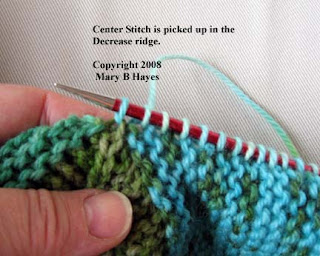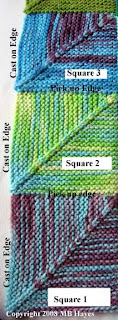
It has been a while since an update on my current miter square afghan. I'm almost done. Here is a photo from 2 weeks ago. All these yarns are koolaid dyed Patons wool.









My sister, Heidi, asked for suggestions on how to select the colors for the squares. I had to think hard about this one as it is something I do on the go.
My only guideline in picking the next color was to try and make sure it looked good with the colors next to it. That and I tried to mix up the blue and the green as much as I could. I didn't have much of the purple, so I tried to keep those far apart. In the last step, you knit the first square (which is #9 in the picture from several posts ago) in column 2. Now the squares get so easy. All you do is pick up 22 stitches from the top of the last square, just like you did in the first column for Squares 2-8. Then you pick up a center stitch, which I have pictured for you. This is the top stitch of the center decrease ridge. Then you pick up 22 stitches on the side like we just did in Steps 2 and 3 for the first square in this column. Now you have all the basic steps for constructing your afghan.
In the last step, you knit the first square (which is #9 in the picture from several posts ago) in column 2. Now the squares get so easy. All you do is pick up 22 stitches from the top of the last square, just like you did in the first column for Squares 2-8. Then you pick up a center stitch, which I have pictured for you. This is the top stitch of the center decrease ridge. Then you pick up 22 stitches on the side like we just did in Steps 2 and 3 for the first square in this column. Now you have all the basic steps for constructing your afghan.
 This first picture shows you the pick up loop of stitch 21. It is the ridge just below the decrease ridge. The next stitch is picked up BEHIND the decrease ridge. The second picture shows this stitch after it is picked up!
This first picture shows you the pick up loop of stitch 21. It is the ridge just below the decrease ridge. The next stitch is picked up BEHIND the decrease ridge. The second picture shows this stitch after it is picked up!
 ide of Square #1 and pick up the next 21 stitches.
ide of Square #1 and pick up the next 21 stitches.  Once you have finished your first column of squares, you build on that column. To do the first (bottom) square in the column you have to cast on 22 stitches and then pickup 23 stitches on the side of square #1. In the picture, Square #1 is the dark blue and the new square is the lighter blue.
Once you have finished your first column of squares, you build on that column. To do the first (bottom) square in the column you have to cast on 22 stitches and then pickup 23 stitches on the side of square #1. In the picture, Square #1 is the dark blue and the new square is the lighter blue.This photo shows 22 stitches cast on the needle and the side of square #1 where you will pick up the stitches.
 Now that you have finished your first two squares, you should see that you knit the squares in columns where the next square is done on top of the previous square. You pick up the stitches of one edge and cast on additional stitches for the other edge. The first picture shows you the first three squares of my afghan.
Now that you have finished your first two squares, you should see that you knit the squares in columns where the next square is done on top of the previous square. You pick up the stitches of one edge and cast on additional stitches for the other edge. The first picture shows you the first three squares of my afghan. In all the remaining columns, you only need to cast on stitches for the FIRST square. All the rest are done by picking up stitches. This second picture shows you the knitting order of the squares in my afghan. I will give you directions for square #9 in my next post.
In all the remaining columns, you only need to cast on stitches for the FIRST square. All the rest are done by picking up stitches. This second picture shows you the knitting order of the squares in my afghan. I will give you directions for square #9 in my next post.







Can you see the pattern? On the right side, you always have one less stitch on each side of the knit ridge stitch. You are decreasing 2 stitches on every right side row. Continue until you have only 3 stitches and you are on the right side. To end, just repeat the decrease between the asterisks, cut the yarn and pull it through the loop. Your first square is finished!
 This blog is dedicated to my mother, Vallanee Hayes. She gave me a life long interest in knitting. I wasn't the only one. All of my siblings (there are six!) are interested in fiber related crafts.
This blog is dedicated to my mother, Vallanee Hayes. She gave me a life long interest in knitting. I wasn't the only one. All of my siblings (there are six!) are interested in fiber related crafts.